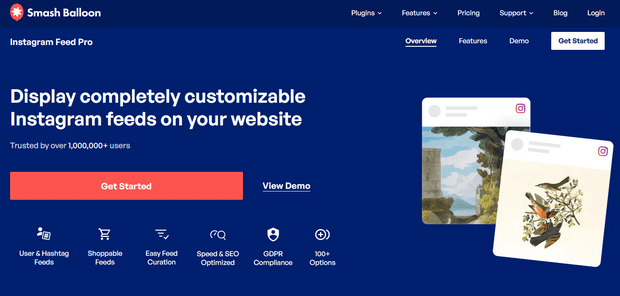Product recommendation: that one tool that has consistently proven its worth in improving your upsell revenue.
These seemingly simple product recommendations can be the difference between a one-time visitor and a loyal customer.
Let’s dive into the world of product recommendations and discover its magic.
- What is Product Recommendation
- Benefits of Product Recommendation
- Product Recommendation Strategies
- How To Make Your Product Suggestions Trustworthy
- Common Mistakes to Avoid
What is Product Recommendation
At its core, a product recommendation is a personalized suggestion made to a shopper based on various factors, such as browsing history, purchase history, or even demographic details.
Think of it as a digital sales assistant, guiding customers towards products they might love, even if they didn’t know they were looking for them.
Benefits of Product Recommendation
- Increased Sales and Conversion Rates: By presenting relevant products, businesses can entice customers to add more to their cart or make a purchase they might have otherwise missed.
- Enhanced Shopping Experience: Recommendations can simplify shopping, helping customers find what they need faster and discover new products they’ll love.
- Building Trust: When done right, personalized recommendations show customers that a brand understands and caters to their unique preferences.
Product Recommendation Strategies
1. Showcase Best Sellers
The opinions of others often influence customers, so highlighting the best-selling and top-rated products can be a powerful product recommendation strategy.
By showcasing these products on the website, businesses can increase their perceived value and make them more attractive to customers.
When recommending your best sellers across your site, using a recent activity popup is one of the strongest tools you can have.
You’ve likely seen them before. They look like this:
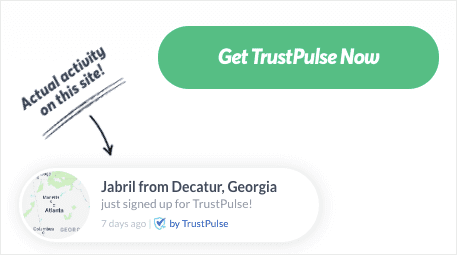
TrustPulse is the leading software for adding these recent activity popups to your website.
You can use recent activity popups to show your best sellers and when other customers have purchased them.
This is an incredibly effective marketing strategy. Why?
Because it leverages the power of fear of missing out, also known as FOMO.
By displaying a recent activity popup every time someone makes a purchase on your website, your visitors will feel like they’re missing out on an opportunity.
How effective are these recent activity popups?
At TrustPulse, we’ve seen them boost sales by up to 15%.
You can also create an entire landing page of best-selling items you think your visitors would enjoy.
Amazon, one of the most successful businesses on the planet, does this on their website:
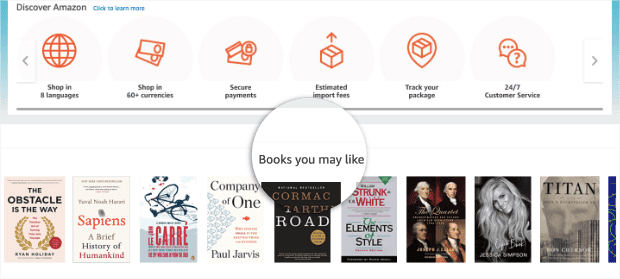
And if it works for them, there’s no reason it won’t work for you.
This is a particularly helpful tip if you’re a new business.
That’s because you need to have a lot of data on your clients’ demographics, interests, or purchase history to make accurate product suggestions.
But if you have items in your product line that have been popular, you can use them to make more general product recommendations across your site.
To easily showcase best selling products on your website, you can use SeedProd.
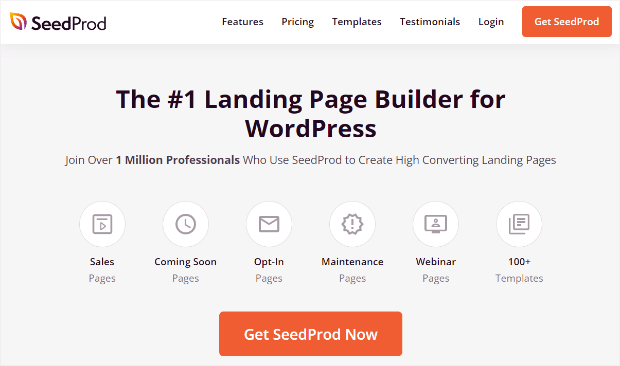
SeedProd is the best landing page builder for WordPress, and comes with custom WooCommerce blocks. Simply drag and drop the Best Selling Products block onto your page.
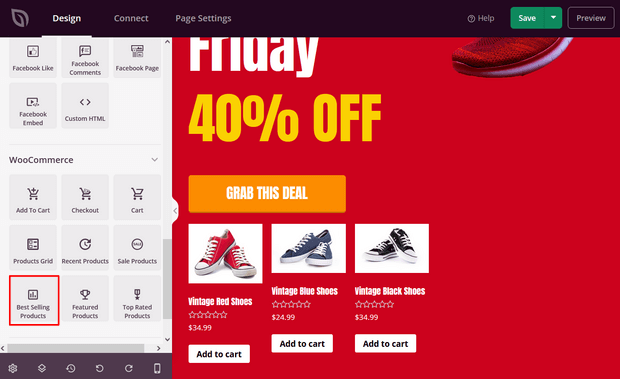
You can choose how many columns of products to display, set the order they appear, choose colors and button styles, and more.
2. Highlight Trending Items
You can make product recommendations based on a current trend. This is an effective strategy around the holidays.
For example, if you run a clothing store, you can use the holiday season to make product recommendations that don’t rely on your customers’ data. These are products that are trending around a certain time of year.
The same can be true of seasonal items. Certain products are more popular in one season of the year, like summer or spring.
Starbucks typically does this at the beginning of each new season:
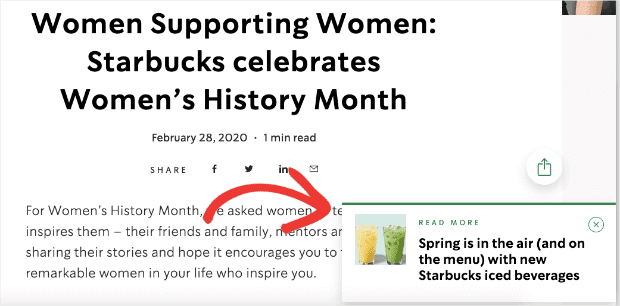
When you spot trends like this, you should use that knowledge to make smarter product recommendations.
3. Promote Discounted Products
Many small and medium-sized businesses miss out on sales because they don’t display their discounts and promotions loudly enough.
If you’re running a special promotion on specific products, you should suggest those products to all your site’s visitors.
Old Navy, for example, uses a Floating Bar campaign at the bottom of their screen to show product offers across their site:
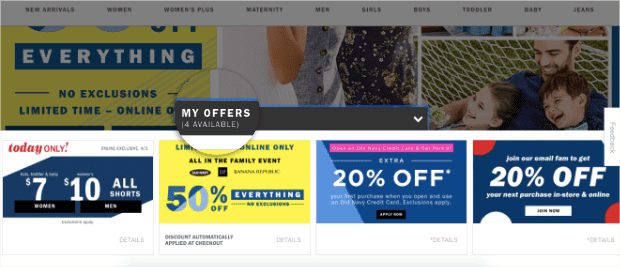
Again, when you see larger companies using cool marketing strategies, they probably do it for a good reason.
Using a Floating Bar campaign is an excellent way to display product-specific discounts and sales on your website.
4. Tailor Personalization Recommendations
Personalization is one of the most powerful strategies for product recommendations.
Businesses can analyze customer data to create personalized product recommendations, including browsing history, purchase history, and demographic information.
These recommendations can be tailored to each customer’s preferences and needs, increasing the likelihood of making a sale.
As you would expect, no one does this better than Amazon:
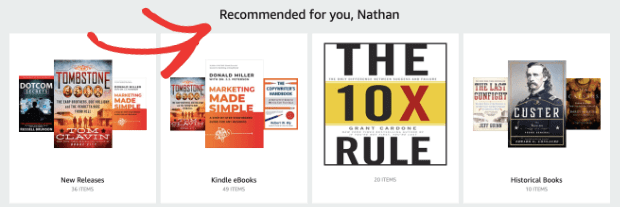
Setting this up is easier than you might think. And no, you don’t need to creep through your users’ browser history or rely on backend recommendation algorithms.
You already have all the information you need.
With OptinMonster’s page-level targeting, for example, you could trigger specific campaigns with suggested products based on what that user has purchased with you in the past.
Page-level targeting with OptinMonster is also an excellent solution for adding recommended products on Shopify, WooCommerce, or other large eCommerce sites, especially if you’re not super comfortable with their platform’s advanced settings.
You can also target your customers based on location using a OptinMonster.
Here’s a product suggestion example from a dessert store suggesting Italian gelato:

Check out how you can make a popup based on location for your product recommendations.
5. Suggest Related Products
Another effective product recommendation strategy is to suggest related products. When a customer is browsing a particular product, businesses can suggest other items that are related to that product.
For example, if a customer looks at a cell phone, related products might include cell phone cases, chargers, or other phone accessories.
By suggesting related products, businesses can encourage customers to make additional purchases and increase the overall value of each transaction.
One of the most effective times for suggesting related products to your clients is at checkout. You’ve likely seen these before while shopping.
Here’s an example from Walmart after adding a BBQ to the shopping cart:
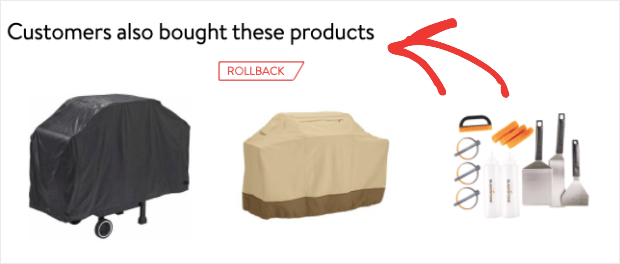
Remember that if you use this method, you need to be careful. If you accidentally make product recommendations unrelated to items in your customers’ shopping cart, it can hurt user experience (UX).
And when it comes to reducing shopping cart abandonment, you need to reduce friction as much as possible.
One way of doing this is content-based filtering. It’s where each of your items has certain descriptors attached to trigger relevant product recommendations.
It’s a popular filtering method for suggesting products, but it can be tedious to set up without the right tools.
But there’s a much simpler way if you’re less technical. You can trigger a campaign for recommended items on a specific product page. It gets the same result but can be done in a lot less time.
Check out this helpful article on how you can make product suggestion campaigns in your customer’s shopping cart with OptinMonster.
6. Engage with Email Marketing Recommendations
So far, we’ve only covered how to recommend products to visitors coming to your site. But you may already have a list of warm leads who would love your recommended products.
We’re talking about your email list.
You can use your email list to send product recommendations to increase sales. And the best part is that you can use this strategy for any platform you’re selling on.
Instead of wasting a Saturday trying to figure out how to recommend products on Amazon, for example, you can create an email marketing campaign and send them to your online store.
Hopefully, you’ve been segmenting your email list to send more personalized suggestions to your audience. This helps you group similar users so you can create more effective campaigns.
But if you haven’t been segmenting your email list, no worries.
Take your most popular products, trending items, or any promotional offers you’re currently running and put them into your automated email series.
In fact, product suggestions can be a powerful part of any email marketing as long as they’re done the right way.
The most important thing to keep in mind is to take the time to write your email copy. When making all product recommendations in your emails, a good rule of thumb is never to come off as too “salesy.”
Otherwise, you risk increasing unsubscribes and hurting your open rates.
Oh, and double-check all of your links. That’s a big problem that happens more often than you think. The last thing you want is an interested buyer landing on a 404 page.
But when done right, sending product suggestions to your email list can effectively boost your revenue.
Check out this example from the Dollar Shave Club:
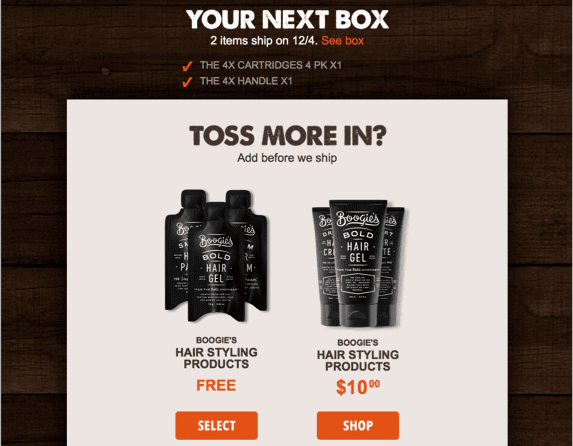
They put their product recommendations in a sleek email campaign. The copy is simple, conversational, and to the point.
This is an excellent example of using email marketing to make powerful product recommendations.
Here’s a great resource that gives you six email marketing templates to save time when writing your email series. You can also use these for a product recommendation email template!
We’ve covered six product recommendation strategies for increasing your sales. Your online business is now one big money-making recommendation engine at this point.
But the truth is that none of these strategies will work if your product suggestions aren’t trustworthy.
Let’s look at five practical things you can do to make your recommendations instantly trustworthy.
How To Make Your Product Suggestions Trustworthy
1. Show High-Quality Photos of Your Product
They say that a picture is worth a thousand words. But when it comes to eCommerce, it might actually be more.
That’s because the human brain can process images much faster than text.
Since a photo will probably be the first impression your clients have of your product, it’s important to make sure your images are high-quality.
Just check out the difference between a product photo like this from the popular baby cream, Butt Paste:

And another product photo from the same company:
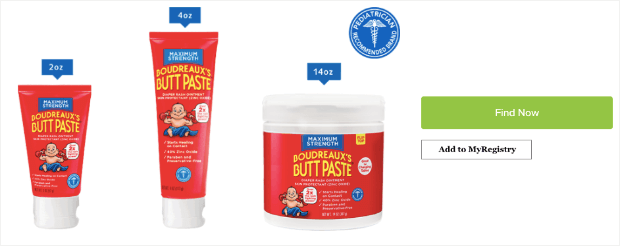
Which one of these two products would you be more likely to purchase? Like most people, you go with the second one.
You don’t need to hire a professional photographer to take images of your products. Most smartphones are now capable of taking high-quality photos.
Here’s a great article to help you find tools to improve your visual content creation skills.
2. Add Trust Signals to Your Product Recommendations
In the past, we’ve written about adding trust signals to your website. You can (and should) do the same thing with product recommendations.
Two powerful trust signals are reviews and testimonials.
Adding a 5-star review scale underneath your product suggestion is a great way of showing other customers that this product has been tested.
Here’s an example of a Shopify-recommended product that is linked from an email campaign:
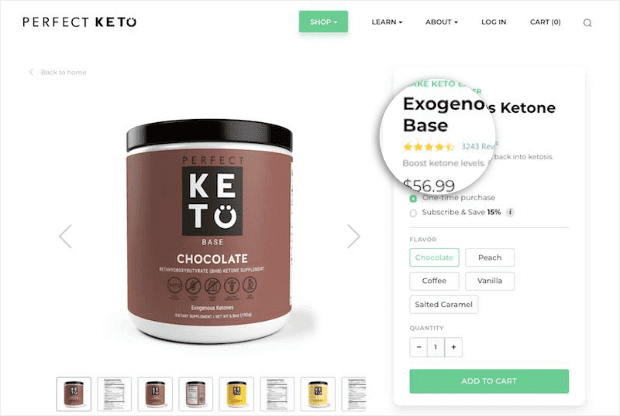
This small addition to the product recommendation Shopify uses can also go a long way toward making more sales for your business.
Netflix uses a “match percentage” to make their suggested movies more credible:

This small trust signal helps users choose which show or movie to watch next.
And if you’re making a product recommendation on a specific web page or in an email, you should definitely add a testimonial. Testimonials are excellent at giving skeptical customers more information about the benefits of your product.
Plus, getting testimonials isn’t nearly as hard as you might think. Read this article if you want to learn how to get killer testimonials for your products easily.
Other trust signals you can include are free shipping badges, free trial seals, or money-back guarantees.
All of these let users know they can try your product at little or no risk making them instantly trust you more.
Resource: How To Respond to Negative Reviews + FREE Response Templates You Can Copy Paste
3. Use Web Copy and Design Best Practices
Earlier in this article, we talked about improving your email copy to help your product recommendations. But the same goes for your product recommendation’s visual design.
If your campaigns are poorly designed, visitors likely won’t stick around long without closing them.
And if you’re making product suggestions with language that sounds like a late-night infomercial, you shouldn’t expect to build much credibility with your audience.
But spending just a few minutes to tighten up your copywriting skills can greatly impact your overall sales.
Here’s a great example of a sleek design with simple language for a product recommendation campaign built with OptinMonster:
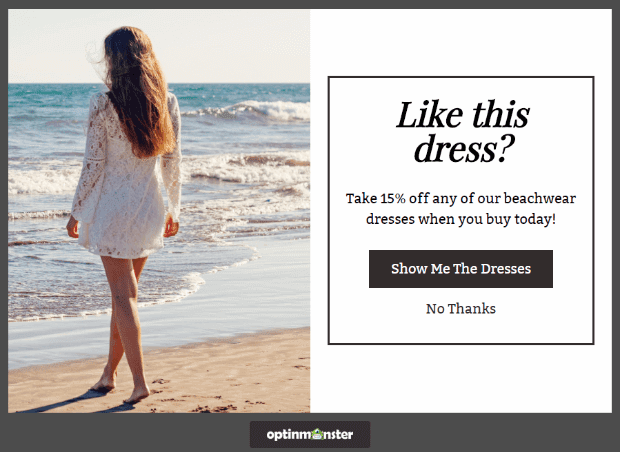
You should focus on a headline that grabs your users’ attention. An easy way to do this is using actionable verbs and power words.
Notice in the campaign from the image above, the headline starts with the verb “like,” rather than “do you like.”
And the call to action is the same, beginning with the verb “show.”
But they could be even stronger with power words. These are key terms that evoke strong emotions in readers.
Need help choosing the right power words? Here’s a list of 700 power words you can use to write more persuasive web copy today.
By crafting the right language for your headlines, product descriptions, and calls to action, you can make your overall message more credible.
You can place your message over a professional-looking design to double down on that credibility.
This will help build trust with your customers and will also serve to make your future recommendations more powerful.
4. Showcase User-Generated Content
Showing user-generated content is another great way to make your product recommendations more trustworthy. Consumers often look to their peers, not brands, for proof of a product’s value.
Here’s how Fenty Beauty does it:
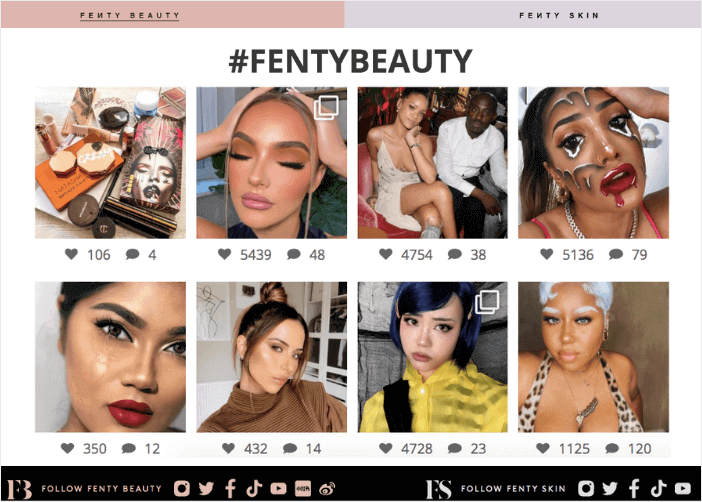
These Instagram photos show real people using Fenty products to create beautiful makeup looks.
Not only does it act as inspiration, but it encourages website visitors to purchase the products to achieve the same results.
So, start encouraging your customers to share their photos on social media with your branded hashtag.
Then, embed an Instagram feed on your website using a plugin like Smash Balloon.
With Smash Balloon’s Instagram Feed Pro, you can easily add an Instagram hashtag feed to any page or post on your WordPress site.
Simply install the plugin, connect your Instagram account, and in less than 30 seconds, you can showcase a beautiful feed of customer photos.
Smash Balloon’s feeds are highly customizable; you can choose from different layouts, design the feed to match your brand, control which content you want to display, and much more.
5. Display Recent Activity Popups
As discussed above, TrustPulse is the leading software for adding these recent activity popups to your website; we know other companies do the same.
That’s why we feel it’s our responsibility to make sure that no matter which company you choose, you avoid a software that allows you to rely on fake social proof.
Some companies allow you to fabricate positive action popups to display purchases that never actually happened. This is a terrible strategy.
Remember, one of the best things you can do for your company is to build up your brand’s reputation. But when your customers know you’re using software that allows fake social proof, they lose trust in your brand.
At TrustPulse, we pride ourselves on only allowing authentic social proof to be displayed on your website. As a result, even our customer’s customers trust us.
Again, even if you decide to use another software, it’s in your best interest to avoid companies that use fake social proof.
Common Mistakes to Avoid
- Over-recommendation: Bombarding users with too many suggestions can be overwhelming and ineffective.
- Irrelevant Suggestions: Recommendations that don’t align with a user’s interest can erode trust.
- Static Recommendations: The digital world is happening. Update and refresh recommendations to avoid missed opportunities.
Product recommendations are more than just a sales tactic; they’re a cornerstone of a modern, customer-centric shopping experience.
When executed correctly, they can transform your ecommerce platform into a personalized shopping haven.
If you’re looking to harness the power of product recommendations, TrustPulse is here to help.
With our expertise and tools, we can help you craft a recommendation strategy that resonates with your audience and drives results.

